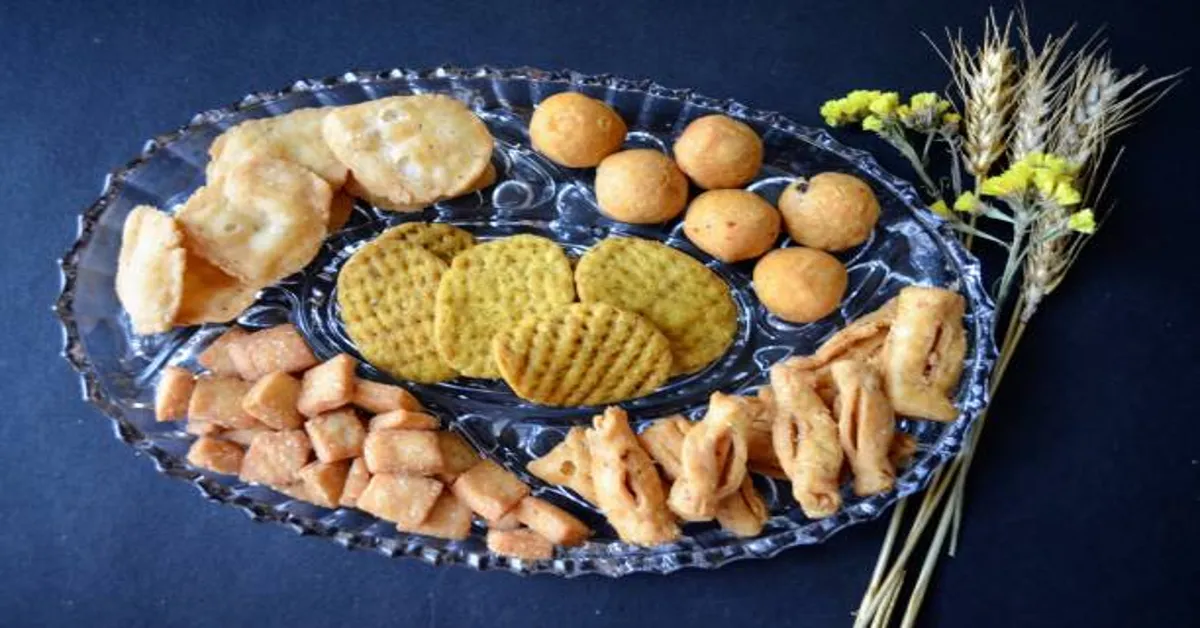Mathia is more than just a crispy snack; it’s a cultural symbol rooted in Gujarati culinary traditions that spans centuries. Popularly enjoyed during festive occasions, Mathia holds a special place in the hearts of many Indians and the Indian diaspora. Whether it’s Diwali, a family get-together, or a tea-time treat, Mathia is often present, offering its signature crunch and flavor. Made from a unique blend of flours, and sometimes even fermented, Mathia showcases the ingenuity and simplicity of Indian cuisine. This article aims to explore the origins, preparation techniques, ingredients, nutritional aspects, cultural relevance, and modern-day adaptations of this beloved snack in great detail.
Origins and Cultural Significance
Mathia has its origins in Gujarat, a western Indian state known for its vibrant food culture and vegetarian culinary excellence. The name “Mathia” derives from “Math” or “Moth,” which refers to moth beans, one of the core ingredients in traditional recipes. Over time, the preparation of Mathia expanded to include other flours such as urad dal (black gram), rice flour, and chickpea flour, depending on regional preferences.
In Gujarati households, Mathia is not just a snack; it’s a ritual. Often prepared weeks before Diwali, it is stored in airtight containers and shared with guests and neighbors as a token of hospitality and festivity. Its preparation is considered a labor of love and is usually a community effort where family members gather to knead the dough, shape the discs, and fry them to perfection. These communal cooking sessions further enrich the cultural bonding among family members and neighbors.
Mathia is also symbolic of prosperity and well-being. Just as sweets like laddoos and barfis mark the sweet beginnings of new endeavors, savory snacks like it offer balance and completion to festive meals.
Ingredients: Simplicity Meets Nutrition
Traditional Mathia is made using a few basic ingredients that are staples in most Indian kitchens. However, the choice of flour and spices varies slightly depending on regional influences or dietary preferences. Below is a detailed list of commonly used ingredients:
1. Flours
- Moth Bean Flour (Math Dal): Rich in protein, this is one of the main flours used in authentic recipes.
- Urad Dal Flour: Often mixed with moth flour to improve texture and enhance fermentation.
- Rice Flour: Helps in making the Mathia crispy.
- Chickpea Flour (Besan): Sometimes used for variation, adding a nutty flavor and boosting protein content.
2. Leavening Agents and Additives
- Papad Khar (Alkaline Salt): Traditionally used to help puff and ferment the dough.
- Baking Soda: In modern recipes, baking soda often replaces papad khar for ease of access.
3. Flavoring and Spices
- Carom Seeds (Ajwain): Enhances digestion and gives a distinct taste.
- Salt: Essential for balance.
- Black Pepper: Adds a hint of spice.
- Asafoetida (Hing): Common in Gujarati snacks for its digestive properties.
4. Oil
- Refined or Groundnut Oil: Used for deep frying. The choice of oil influences both taste and health.
Traditional Preparation Method
Preparing Mathia is both an art and a science. It requires careful selection of ingredients, precise kneading of dough, and a well-controlled frying process. Here’s a step-by-step breakdown:
Step 1: Mixing the Flours
Combine moth bean flour, urad dal flour, and rice flour in a large mixing bowl. Add the spices (ajwain, pepper, hing, salt) and mix thoroughly. Sieve the flours if needed to remove lumps and impurities.
Step 2: Adding the Leavening Agent
Add papad khar or baking soda to the flour mixture. If using papad khar, dissolve it in warm water before adding to ensure even distribution. Knead the flour mixture into a firm yet pliable dough.
Step 3: Resting the Dough
Let the dough rest for at least 3 to 4 hours or overnight if you want a mildly fermented flavor. This resting phase is crucial to develop texture and flavor.
Step 4: Shaping the Mathia
Break the dough into small, equal-sized balls. Flatten them using your palms or a rolling pin to form thin discs. Traditionally, a slight depression is made in the center of each disc.
Step 5: Frying
Heat oil in a deep frying pan or kadhai. Drop each it into the hot oil and fry on medium heat until it puffs up and turns golden. Remove and drain on paper towels.
Step 6: Storage
Allow them to cool completely before storing in airtight containers. When stored properly, it can stay crisp and fresh for several weeks.
Variations Across Regions
Though Mathia is most commonly associated with Gujarat, its popularity has led to various regional and even international adaptations. Some popular variations include:
1. Masala Mathia
Spicier than the traditional version, masala it includes added ingredients like red chili powder, sesame seeds, and dried fenugreek leaves.
2. Moong Dal Mathia
In this version, moong dal flour replaces moth bean flour, offering a slightly different taste and nutritional profile.
3. Gluten-Free Mathia
Using only rice and lentil-based flours makes it a gluten-free snack suitable for people with gluten intolerance.
4. Baked Mathia
Health-conscious individuals often opt for baking instead of frying. Though slightly less crispy, baked Mathia still offers great taste and is lower in fat.
Nutritional Value and Health Considerations
While Mathia is primarily a snack, it offers more than just taste. Its nutritional profile depends on the ingredients and cooking method used.
Per 100g Fried Mathia (Approximate)
- Calories: 400-450 kcal
- Protein: 10-15 g
- Carbohydrates: 50-55 g
- Fats: 20-25 g
- Fiber: 4-6 g
Health Benefits
- High in Protein: Thanks to lentil flours, it can be a decent source of plant-based protein.
- Gluten-Free Options: Suitable for those with celiac disease or gluten sensitivity.
- Good Shelf Life: Can be stored for weeks without preservatives.
- Digestive Spices: Ingredients like ajwain and hing aid digestion.
Health Concerns
- High in Fat: Especially when deep-fried, it can be calorie-dense.
- Sodium Content: Excessive salt or papad khar may not be ideal for individuals with hypertension.
- Not Ideal for Daily Consumption: Best enjoyed occasionally due to its deep-fried nature.
Modern-Day Popularity and Market Availability
In today’s globalized world, Mathia is not just restricted to Indian homes. It’s available in Indian grocery stores across North America, Europe, the Middle East, and Australia. It is often sold in vacuum-sealed packets to maintain crispness. Many brands also offer masala and diet versions to cater to health-conscious consumers.
You can also find Mathia on the menu in Indian restaurants, especially those specializing in Gujarati cuisine. Some modern cafés even use it in fusion snacks, pairing it with cheese dips or spicy chutneys.
Mathia in Festivals and Rituals
The significance of Mathia during Diwali cannot be overstated. In many households, it is one of the first snacks prepared during the festive season. It’s part of the “farsan” or savory platter offered to guests along with sweets like chakli, sev, and shakkarpara.
Women of the household often gather to prepare large batches, sometimes making hundreds of Mathia pieces in a single day. These are then packed in decorative boxes and shared with friends, neighbors, and family. It’s not just a snack—it’s a tradition, a connection to roots, and an offering of love.
Tips for Making Perfect Mathia at Home
- Use Fresh Ingredients: Always use fresh flours and spices for optimal flavor and texture.
- Rest the Dough: This step is critical for the fermentation process and affects the puffiness.
- Right Temperature for Frying: Too hot and it will burn; too cool and it won’t puff up.
- Avoid Overcrowding: Fry in small batches for even cooking.
- Cool Before Storing: Moisture will ruin texture if packed while still warm.
Conclusion
Mathia is not just a crunchy snack; it’s a symbol of celebration, community, and heritage. From its humble origins in Gujarati kitchens to its global popularity among Indian communities worldwide, it continues to charm palates across generations. Whether homemade with love or purchased from a specialty store, it remains a timeless delicacy that brings people together.
By understanding its ingredients, preparation methods, and cultural significance, one not only appreciates its taste but also the rich culinary traditions it represents. While health-conscious versions exist for those watching their diet, the classic it remains an unbeatable favorite, especially during festive times. So the next time you savor this crunchy delight, remember—it’s not just food; it’s a story told through flavor, texture, and tradition.
ALSO READ: SignUp Genius: A Complete Guide to Smarter Event Planning and Volunteer Coordination
Frequently Asked Questions (FAQs)
1. What is Mathia made of?
Mathia is typically made from a blend of moth bean flour and urad dal flour, with spices like ajwain and hing, and deep-fried until crispy.
2. Is Mathia gluten-free?
Yes, traditional Mathia made with lentil and bean flours is naturally gluten-free. However, always check ingredient labels for commercial products.
3. How long can Mathia be stored?
When stored in airtight containers in a cool, dry place, Mathia can remain fresh and crisp for up to 3–4 weeks.
4. Can Mathia be baked instead of fried?
Yes, baking is a healthier alternative, though the texture may be slightly different. It reduces oil content significantly.
5. Is Mathia healthy?
Mathia offers good protein and fiber due to lentil flours, but deep-frying increases calorie and fat content. It is best enjoyed in moderation.









